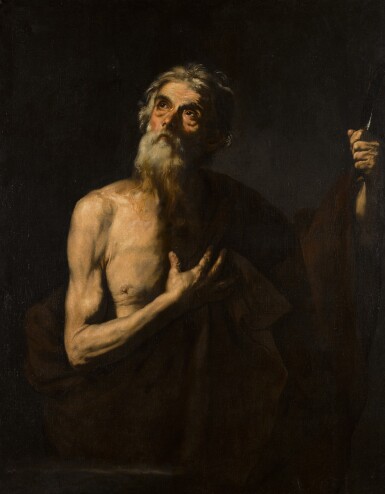Old Masters Evening Sale
Old Masters Evening Sale

Property from a Private Collection
Jusepe de Ribera, called lo Spagnoletto
Saint Bartholomew 《聖巴爾多祿茂》
Auction Closed
December 8, 08:20 PM GMT
Estimate
100,000 - 150,000 GBP
Lot Details
Description
Property from a Private Collection
Jusepe de Ribera, called lo Spagnoletto
Játiva, Valencia 1591 - 1652 Naples
Saint Bartholomew
indistinctly signed and dated lower centre: J. Ribera español... 1634
oil on canvas
127.2 x 101 cm.; 50⅛ x 39¾ in.
私人收藏
胡塞佩・德・里貝拉,或稱洛・斯帕尼奧萊托
1591年生於瓦倫西亞哈蒂瓦,1652年卒於拿坡里
《聖巴爾多祿茂》
款識:藝術家簽名並紀年J. Ribera español... 1634(中下,略模糊)
油彩畫布
127.2 x 101 公分;50 ⅛ x 39 ¾ 英寸
Émile Pacully (1875–1903), Paris;
His sale, Paris, Galerie Georges Petit, 4 May 1903, lot 53 (as Saint Andrew);
Anonymous sale, Paris, Hôtel Drouot, 5 July 1938, lot 27, for 17,000 francs (as Saint Andrew);
With Arnold Seligmann, Rey & Co., New York;
City Art Museum, Saint Louis, Missouri, 1939–1985;
By whom sold, New York, Christie's, 5 June 1985, lot 54 (as workshop of Ribera);
Anonymous sale, New York, Christie's, 12 January 1996, lot 100 (as Ribera);
With Stanley Moss & Company, Riverdale on Hudson, New York;
Private collection, Barcelona.
M.R. Rogers, ‘St Bartholomew by Jusepe de Ribera’, in Bulletin of the City Art Museum of St Louis, January 1939, vol. XXIV, no. 1, pp. 3–6, reproduced (as Ribera);
Art News, vol. XXXVII, 11 February 1939, pp. 17–18, reproduced (as Ribera);
Handbook of the Collections: The City Art Museum of St Louis, St Louis 1953, p. 89, reproduced (as Ribera);
‘Exhibition of Paintings and Graphics by Jusepe de Ribera’, in Allen Memorial Art Museum Bulletin, 1957, vol. XIV, n. 2, p. 74, no. 3, reproduced (as Ribera);
J.A. Gaya Nuno, La Pintura Espanola Fuera de Espana, Madrid 1958, p. 277, no. 2291 (as Ribera);
C. Felton, Jusépe de Ribera: A Catalogue Raisonné, unpublished PhD. diss., 1971, p. 441, no. X-61 (as workshop, under Unaccepted Attributions);
A.E. Pérez Sánchez and N. Spinosa, La Obra Pictorica de Ribera, Madrid 1979, p. 131, no. 293, reproduced (as probably a workshop version of a lost original painted circa 1630–32);
N. Spinosa, Ribera, L'opera completa, Naples 2003, p. 291, no. A136, reproduced (as Ribera, signed and dated 1634);
N. Spinosa, Ribera. L’opera completa, Naples 2006, p. 318, no. A158, reproduced (as Ribera, bearing signature and date 1634);
N. Spinosa, Ribera. La obra completa, Madrid 2008, p. 398, no. A178, reproduced (as Ribera, bearing signature and date 1634).
After this painting was cleaned, which occurred sometime after its sale in 1985 and before the one that took place over a decade later in 1996, Professor Emeritus Craig Felton, Dr William B. Jordan and Professor Nicola Spinosa all endorsed its attribution to Jusepe de Ribera.
This Saint Bartholomew probably originally formed part of a set depicting the twelve apostles, of which the others are lost or destroyed. Ribera painted several series of the apostles throughout his career, the most complete being that now housed in the Museo del Prado, Madrid, executed in circa 1630 and mentioned for the first time in the Spanish Royal Collection towards the end of the eighteenth century. The present painting also belonged to Spanish royalty – Don Infante Sebastian Gabriel Borbón y Braganza, the son of Pedro de Borbón and the Princessa de Braganza. He was married first to Maria Amalia of Naples and then in 1860 to Maria Cristina (1833–1902), the sister-in-law of Queen Isabella II. An artist in his own right, in 1827 he was elected Académico de Mérito of the Academia de Bellas Artes de San Fernando, Madrid, and was also a patron of contemporary artists. The formation of his remarkable collection, however, began with inheritances from his father and was augmented by the property of his two wives and the purchases he made through his friend, the painter José de Madrazo y Agudo, who acted as intermediary. Although an inventory made in 1835 reveals that by this early date his collection was almost complete, he had not by that point acquired this painting.1
An old copy of the present painting, today in the Museo Municipal de Bellas Artes Juan B. Castagnino,2 depicts the same figure seen here in the guise of Saint Andrew, holding a fish instead of a knife.
1 La Galleria de Pinturas de S.A.R. el Sermo. Señor. Ynfante Don Sebastián Gabriel, in M. Agueda Villar, ‘La colección de pinturas del infante Don Sebastián Gabriel’, in Boletin del Museo del Prado, vol. III, no. 8, 1982.
